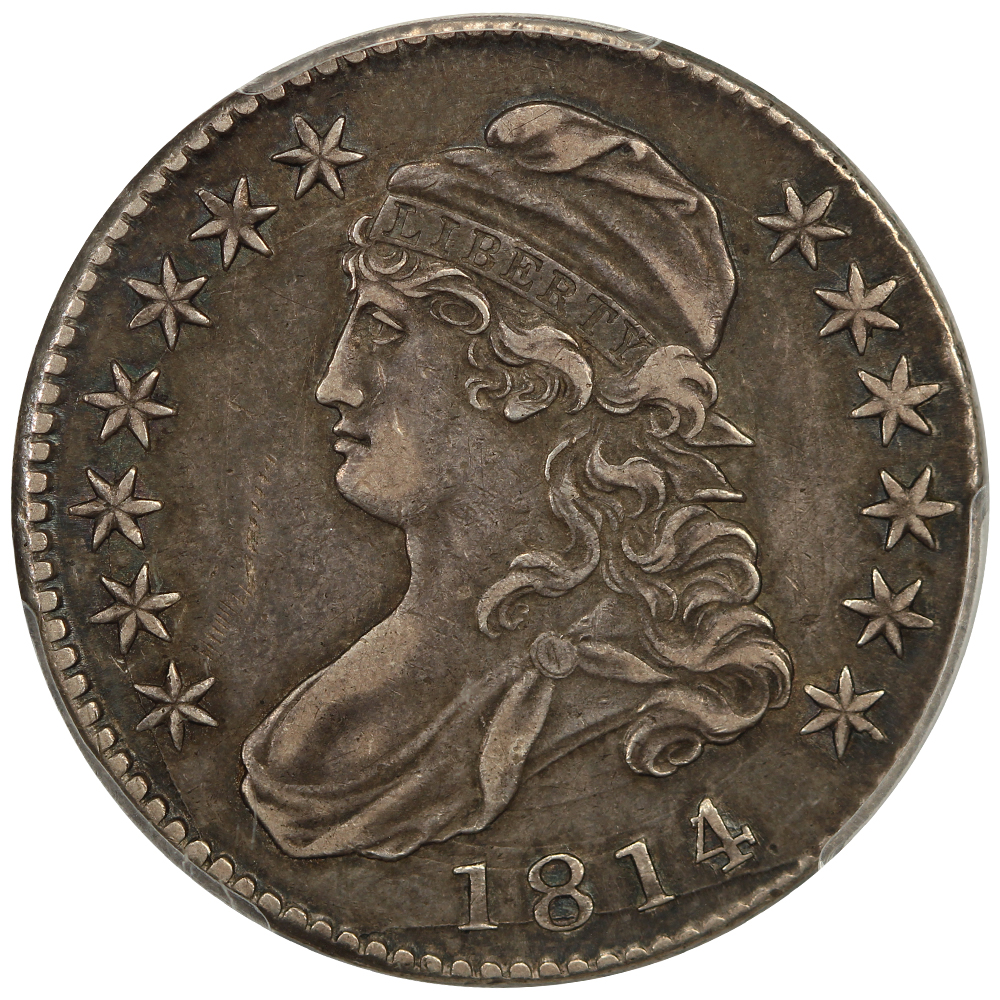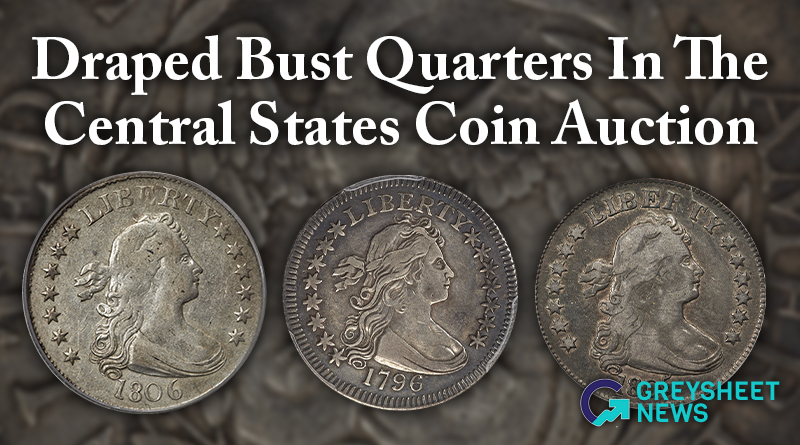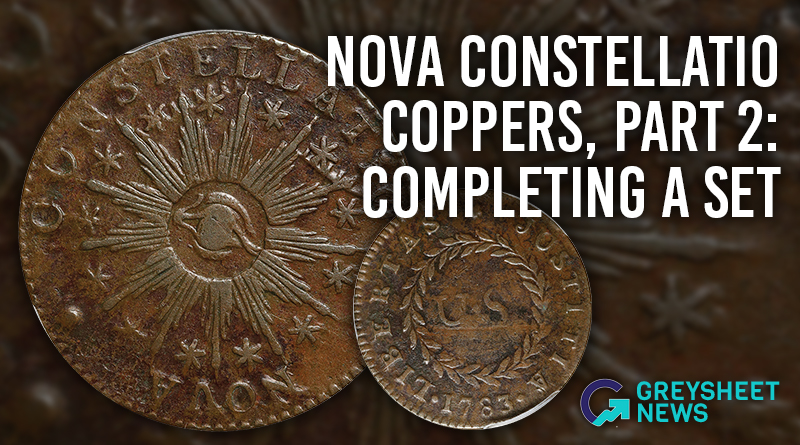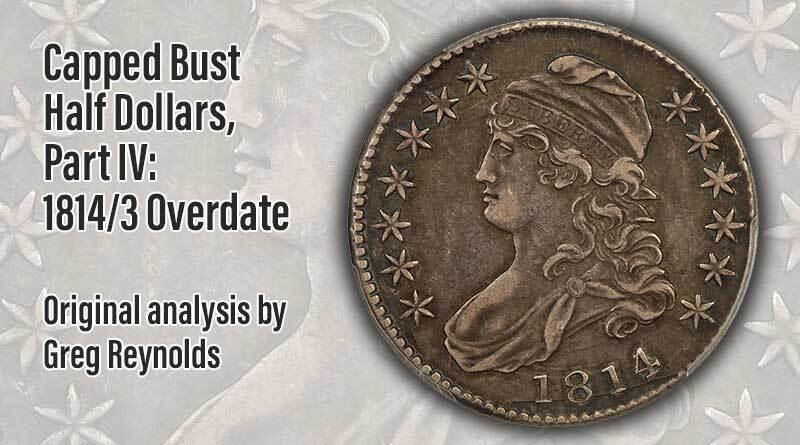Reich Capped Bust Half Dollars, Part 4: 1814/3 Overdate
In this article Greg Reynolds analyzes a semi-key date in the Capped Bust Half Dollar series, the 1814/3.
It has been a while since the publication of part 3 in this series, 1811/0 with period , though Capped Bust half dollars continue to be extremely popular and favorites of mine. In part 1, the requirements for a set are discussed. The 1807 is the topic of part 2 . Whether the 1814/3 overdate is referred to as a major variety or as a very scarce date, it is distinctive, and it has not commanded the respect that it deserves.
While viewing one of these, it is apparent without magnification that the 4 in 1814 has elements underneath, which are not parts of the numeral ‘4!’ On all 1814/3 halves, both ends of the top part of the three are apparent and stick out of the sides of the numeral 4. In those days, numerals were punched by hand into dies, and it is clear that a 3 was replaced by a 4. Not all overdates have the status of a distinct date. An overdate that is readily apparent without magnification, and captures attention, is often granted this status.
It is true that the overdate features of the 1817/3 are more pronounced. Even so, the 1814/3 is clearly apparent. Both an 1814/3 and an 1814 with normal (regular) numerals should be included in a set by date of Reich Lettered Edge halves (1807-36).
The 1814/3 overdate is not rare, though is very scarce. PCGS reports a population of 393 1814/3 overdate half dollars, less than the population of 495 1815/2 halves! The 1815/2 is a key date. Furthermore, the NGC census reports 141 1814/3 halves and 277 1815/2 coins.
Of course, the 1814/3 is not as scarce as the 1815/2. Resubmissions in all grades and the submissions of very low grade 1815/2 halves probably account for the fact that the certified population of 1814/3 halves is lower. Moreover, unless a coin is relatively expensive, many collectors of circulated half dollars prefer their coins to be always raw (not encapsulated) and there is not as much of a financial reason to submit a low grade 1814/3 as there is for an equivalent 1815/2.
It is a realistic possibility that most Good-4 grade 1814/3 halves will never be sent to PCGS, NGC or CAC. Further, a PCGS or NGC graded G4 1814/3 may later be cracked out by a collector who prefers raw coins. A Good grade 1815/2 half, in contrast, is likely to be submitted, and an already PCGS or NGC G4 grade 1815/2 is less likely to be cracked out to be collected raw than most other certified G4 grade bust half dollars.
The Greysheet Bid, an estimate of a top wholesale price, for a G4 grade 1814/3 is $135, while Greysheet Bid for a G4 grade 1815/2 is $1,550. Grading fees and shipping costs might amount to a significant percentage of $135. Moreover, if a collector spends $160 for a raw Good grade 1814/3 half at a small coin show or at a flea market, and later learns that it is fake or problematic, then $160 is not that much to lose in the context of classic U.S. coins. The purchase of an uncertified, Good grade 1815/2, in contrast, might cost from $1,500 to $2,000. More expensive coins are far more likely to be certified than less expensive coins of the same design type of classic U.S. coins, and this point should be taken into consideration while interpreting population reports.
If the PCGS and NGC data reflect about four hundred different 1814/3 halves with numerical grades plus another eighty in Details holders and five hundred that are raw, then there are less than one thousand 1814/3 halves extant. As many thousands of people collect Capped Bust half dollars, the 1814/3 is more important than it has been reported to be. Even so, an 1814/3 with a clear enough overdate may be acquired in the near future without spending a fortune.
Certainly, the overdate is readily visible on the NGC graded VG8 1814/3 that Heritage sold on March 21, 2017, for $199.75. On August 28, 2022, DLRC sold a PCGS graded VF20 1814/3 for $475. On June 11, 2023, the firm called GreatCollections sold an NGC graded VF30 1814/3 for $738.
On January 5, 2021, Heritage auctioned a PCGS graded VF35 1814/3 , with a sticker of approval from CAC, for $720, a moderate to slightly strong price. On July 24, 2022, DLRC sold a PCGS graded XF40 1814/3 for $1,016.

1814/3 Half Dollar, PCGS XF40
On May 21, 2023, GreatCollections sold a PCGS graded XF45 1814/3, with a CAC sticker, for $1,870. This coin was probably cleaned more than a century ago, perhaps during the nineteenth century, and has since naturally retoned. It is much different in color from most surviving, naturally toned 1814/3 halves.

184/3 Half Dollar, PCGS/CAC XF45
On November 6, 2022, GreatCollections sold an NGC graded AU50 1814/3 for $1,270.50. On September 18, 2020, Heritage sold a PCGS graded MS64+ 1814/3 , with a CAC sticker, for $17,400.
These tend to be richly toned and the toning is often thick. Russet and brown colors usually dominate naturally toned 1814/3 half dollars, often with greenish hues. In some cases, there are violet tints. Once in a while, I see touches of blue or orange-russet on one of these, but it is really the relatively dark russet and brown hues that appear most often on 1814/3 half dollars.
As certified Mint State grade 1814/3 halves tend to bring large multiples of their sub-60 grade counterparts, and many circulated 1814/3 halves have appealing natural toning, I suggest that VF20 to AU55 grade 1814/3 halves are often better values than uncirculated coins, from a logical perspective.
A collector who is unsure in regard to pursuing an 1814/3 may wish to buy one that is certified as grading from VG8 to VF30; these are much less expensive than certified XF40 to MS62 grade 1814/3 halves and sometimes score much higher in the category of originality.
Copyright ©2023 Greg Reynolds
Insightful10@gmail.com
Images are shown courtesy of Heritage Auctions (ha.com), GreatCollections.com and DLRC (www.davidlawrence.com).

Download the Greysheet app for access to pricing, news, events and your subscriptions.
Subscribe Now.

Subscribe to RQ Red Book Quarterly for the industry's most respected pricing and to read more articles just like this.
Source: Greg Reynolds
Related Stories (powered by Greysheet News)
View all news
The Lusk set of Draped Bust quarters brought strong results.

The 1889-CC is the second scarcest business strike in the series.

Just six coins are required for a set of true Nova Constellatio Coppers, and the coins selected need not be very expensive.









Please sign in or register to leave a comment.
Your identity will be restricted to first name/last initial, or a user ID you create.
Comment
Comments